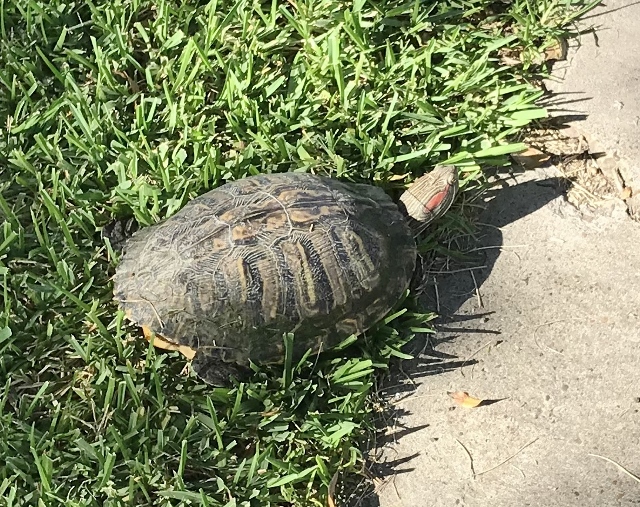By Anita Westervelt, Texas Master Naturalist
It’s unusual to see a big pond slider turtle lumbering across the lawn at a good clip — away from the water.
Two of the most common turtles in Texas are the pond slider and red-eared slider. They are medium-sized semiaquatic turtles and live in fresh and brackish water, but not in saltwater.

Slider turtles have oblong heads with snouts that point upward. They have webbed feet for swimming and spend most of their time in water — ponds, lakes, rivers, swamps, marshes, resacas and irrigation ditches. They prefer shallow, slow-moving water with abundant vegetation and muddy bottoms.
It’s common to see pond sliders amassed two and three deep, basking on fallen tree trunks or other structures peeking out of the water. At the least noise or perceived threat, the structure is immediately cleared as the turtles slide into the water. According to some, this is how the name, slider, came about.
Female sliders do leave the water to build their nests between April and July. They can travel sometimes more than a mile over land searching for a safe habitat. You may find them building nests after dark or during periods of rain.
The female turtle digs a hole two to four inches deep, using her back feet. She can lay from four to 23 oval eggs. She will cover the eggs with soil. After 60 to 90 days, the juveniles begin to hatch — generally between July and September. An adult female slider will lay one to two clutches per year, possibly up to four.
Hatchlings are completely on their own requiring no care from adult turtles. Juveniles feed on insects like spiders, beetles and grasshoppers, and tadpoles, fish, snails, slugs, and occasionally flesh of dead animals.
Adult turtles become omnivores and feed mostly on aquatic and terrestrial plants, consuming stems, leaves, flowers and seeds. They also consume algae regularly and decaying pond matter. Adult sliders also eat insects, small fish and carrion
An adult slider shell averages between five and eight inches long. The upper portion of the shell is called the carapace. It is oval-shaped with sharp edges, and the surface is rough with indentations that vary directionally.
On the common slider, the coloring of the carapace ranges from greenish yellow to gray, brown, and black. Large yellow lines are often present on the carapace.
The bottom shell is called the plastron. It tends to be lighter in color than the carapace, and it is usually yellow with black spots or streaks. The skin is dark green and yellow.
A turtle’s shell is covered by plate-like substances called scutes, which are made up of keratin, the same substance as a human’s fingernails. Scutes are often sluffed off as the turtle grows, making way for the newer, larger scutes.
Red-eared sliders have a bright red streak behind their eyes. Their carapace is dark brown to olive green and can grow as big a 12 inches long. They are found throughout the United States, and have been introduced into Canada, Mexico, Israel and Africa.

Sources: “Critters of Texas Pocket Guide,” Adventure Publications, Inc. Online sources, Animaldiversity.org, tpwd.texas.gov and Wikipedia.org
